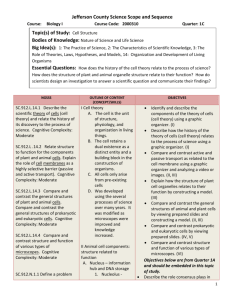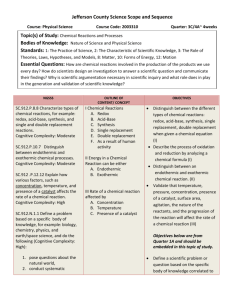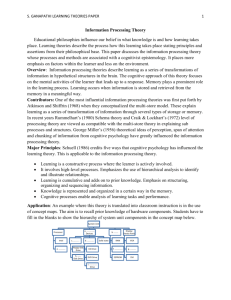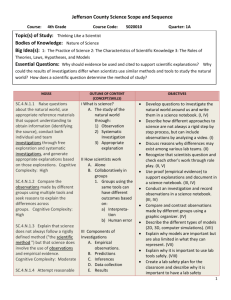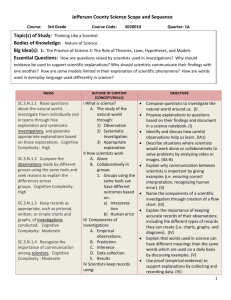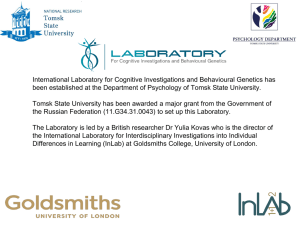Topic 2: Matter - Jefferson County School District
advertisement
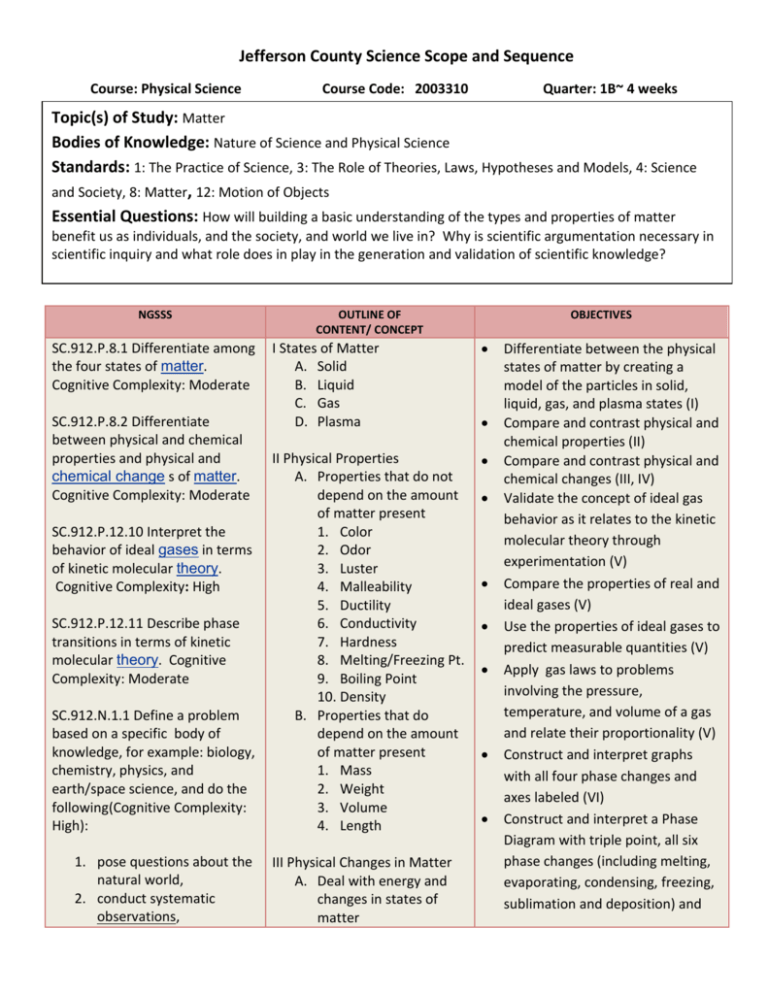
Jefferson County Science Scope and Sequence Course: Physical Science Course Code: 2003310 Quarter: 1B~ 4 weeks Topic(s) of Study: Matter Bodies of Knowledge: Nature of Science and Physical Science Standards: 1: The Practice of Science, 3: The Role of Theories, Laws, Hypotheses and Models, 4: Science and Society, 8: Matter, 12: Motion of Objects Essential Questions: How will building a basic understanding of the types and properties of matter benefit us as individuals, and the society, and world we live in? Why is scientific argumentation necessary in scientific inquiry and what role does in play in the generation and validation of scientific knowledge? NGSSS SC.912.P.8.1 Differentiate among the four states of matter. Cognitive Complexity: Moderate SC.912.P.8.2 Differentiate between physical and chemical properties and physical and chemical change s of matter. Cognitive Complexity: Moderate SC.912.P.12.10 Interpret the behavior of ideal gases in terms of kinetic molecular theory. Cognitive Complexity: High SC.912.P.12.11 Describe phase transitions in terms of kinetic molecular theory. Cognitive Complexity: Moderate SC.912.N.1.1 Define a problem based on a specific body of knowledge, for example: biology, chemistry, physics, and earth/space science, and do the following(Cognitive Complexity: High): 1. pose questions about the natural world, 2. conduct systematic observations, OUTLINE OF CONTENT/ CONCEPT OBJECTIVES I States of Matter A. Solid B. Liquid C. Gas D. Plasma II Physical Properties A. Properties that do not depend on the amount of matter present 1. Color 2. Odor 3. Luster 4. Malleability 5. Ductility 6. Conductivity 7. Hardness 8. Melting/Freezing Pt. 9. Boiling Point 10. Density B. Properties that do depend on the amount of matter present 1. Mass 2. Weight 3. Volume 4. Length III Physical Changes in Matter A. Deal with energy and changes in states of matter Differentiate between the physical states of matter by creating a model of the particles in solid, liquid, gas, and plasma states (I) Compare and contrast physical and chemical properties (II) Compare and contrast physical and chemical changes (III, IV) Validate the concept of ideal gas behavior as it relates to the kinetic molecular theory through experimentation (V) Compare the properties of real and ideal gases (V) Use the properties of ideal gases to predict measurable quantities (V) Apply gas laws to problems involving the pressure, temperature, and volume of a gas and relate their proportionality (V) Construct and interpret graphs with all four phase changes and axes labeled (VI) Construct and interpret a Phase Diagram with triple point, all six phase changes (including melting, evaporating, condensing, freezing, sublimation and deposition) and Jefferson County Science Scope and Sequence 3. examine books and other sources of information to see what is already known, 4. review what is known in light of empirical evidence, 5. plan investigations, 6. use tools to gather, analyze, and interpret data (this includes the use of measurement in metric and other systems, and also the generation and interpretation of graphical representations of data, including data tables and graphs), 7. pose answers, explanations, or descriptions of events, 8. generate explanations that explicate or describe natural phenomena (inferences), 9. use appropriate evidence and reasoning to justify these explanations to others, 10. communicate results of scientific investigations, and 11. evaluate the merits of the explanations produced by others. SC.912.N.1.5 Describe and provide examples of how similar investigations conducted in many parts of the world result in the same outcome. Cognitive Complexity: Moderate SC.912.N.1.6 Describe how scientific inferences are drawn B. Does not produce a new substance C. Solutions/Mixtures 1. Suspension 2. Colloid 3. Emulsion IV Chemical Changes in Matter A. Take place on the molecular level B. Produces a new substance V Properties of gases A. Ideal B. Real C. Gas Laws 1. Boyles 2. Charles 3. Gay Lussacs VI Kinetic energy of matter A. Particle size B. Particle motion C. Particle mass D. Phase changes 1. Evaporation 2. Sublimation 3. Condensation 4. Melting Point 5. Boiling Point 6. Deposition axes labeled to demonstrate the Kinetic Molecular theory. (VI) Relate particle motion, distance between particles, and temperature for each state of matter. (VI) Objectives below are from Quarter 1A and should be embedded in this topic of study. Define a scientific problem or question based on the specific body of knowledge correlated to the Physical Science course. Explain the difference between an experiment and other types of scientific investigations Define a scientific problem or question based on the specific body of knowledge correlated to the Physical Science course. Explain the difference between an experiment and other types of scientific investigations Explain that scientific knowledge is durable because it is open to change as new evidence or interpretations are encountered. Describe the role consensus plays in the historical development of a theory in Physical Science. Explain how scientific knowledge and reasoning provide an empirically-based perspective to inform society's decision making. Justify conclusions based upon all the available evidence, not on expressed opinions Distinguish between a scientific theory and a general claim Distinguish between laws and theories by understanding that laws describe what and theories Jefferson County Science Scope and Sequence from scientific observations and provide examples from the content being studied. Cognitive Complexity: Moderate SC.912.N.3.3 Explain that scientific laws are descriptions of specific relationships under given conditions in nature, but do not offer explanations for those relationships. Cognitive Complexity: Moderate SC.912.N.3.4 Recognize that theories do not become laws, nor do laws become theories; theories are well supported explanations and laws are well supported descriptions. Cognitive Complexity: Moderate LACC.910.RST.3.7 The student will organize information to show understanding or relationships among facts, ideas, and events (e.g., representing key points within text through charting, mapping, paraphrasing, summarizing, comparing, contrasting, or outlining). explain why
